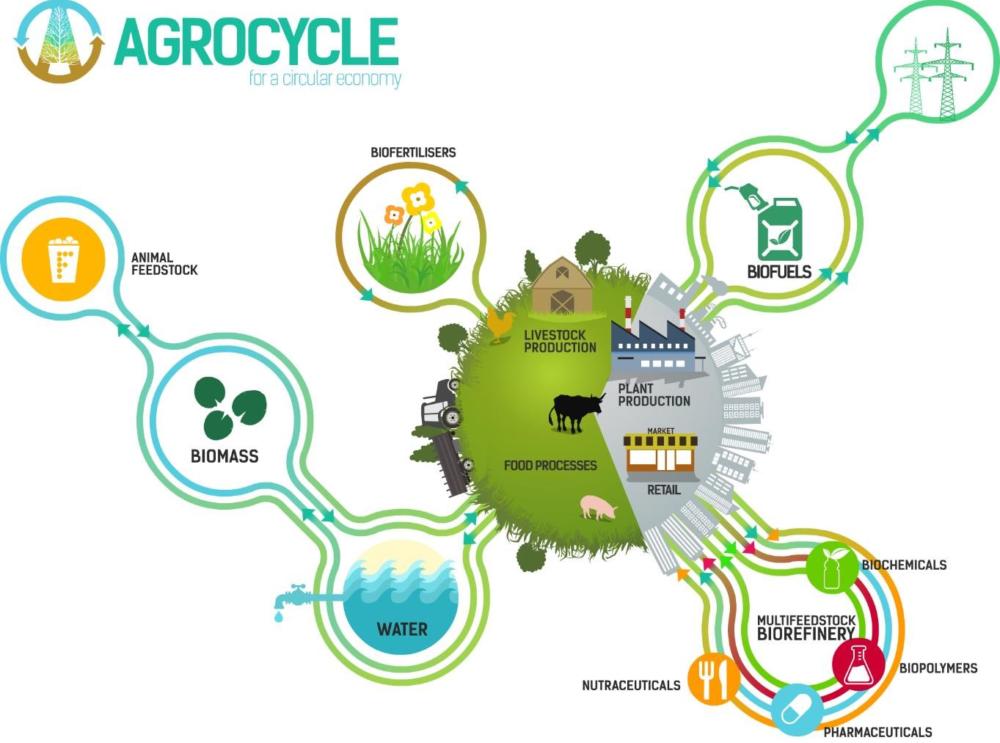AgroCycle – For a Circular Economy

The Microbiology Society is undertaking a project entitled A Sustainable Future as part of our 75th Anniversary, which aims to highlight the Sustainable Development Goals (SDGs) to our members and empower them to use their research to evidence and impact the goals. Earlier this year, we put a call out to our members to submit case studies in the following three areas: antimicrobial resistance, soil health and the circular economy.
This case study is written by Dr Simon Jeffery, Reader in Soil Ecology and Dr Marie Kirby, Senior Lecturer at Harper Adams University, UK. It focuses on the circular economy; an alternative to a traditional linear economy (make, use, dispose), in which we keep resources in use for as long as possible, extract the maximum value from them while in use, then recover and regenerate products and materials at the end of each service life.
Introduction to Project
The €8 million Horizon 2020 AgroCycle consortium comprised 26 partners from eight EU countries, two from China, and one from Hong Kong. Led by the School of Biosystems and Food Engineering at University College Dublin, Ireland, it developed a protocol for the application of the circular economy across the agri-food sector. A key aspect of this was understanding how to make best use of the full range of agri-food waste streams.

What are the challenges/needs that this research/initiative addresses?
In Europe, about 90 million tonnes of food are wasted annually, and The Food and Agriculture Organization of the United Nations (FAO) has predicted this will grow by an additional 40% by 2025. China is estimated to waste in the region of £20 billion of food per annum. This waste is an issue, particularly when contrasted against a background of expanding food demand. However, much of the material that is wasted, or considered waste, comprises of under-utilised by-products and co-products, which can arise at multiple stages in the food chain, or materials that have alternative re-use value.
What findings and solutions were provided by this research/initiative?
The AgroCycle Protocol presents a blueprint for a pan-European agri-food circular economy. Specific outputs include a range of new biodegradable materials from agri-waste, such as rice bran, which can be used in packaging and is a replacement for single use plastics. The AgroCycle-Platform, trading platform for agri-food waste matches waste producers with end-users, and builds connections with potential users who can reuse, or recycle various waste components.
In terms of microbiology, two of the findings published recently concern anaerobic digestion (AD), a renewable energy technology that converts organic crops, wastes and residues into biogas for electricity and heat generation. Animal slurries and manures are typically used as feedstocks for AD. A by-product of this process is digestate, which contains plant essential nutrients and can be applied to soil to off-set fertiliser demand.
Poultry manure produced from egg laying hens and meat producing chickens may contain pathogens excreted from the flock, such as Staphylococcus aureus. If these remain viable after the AD process, this has implications for digestate management. Furthermore, if S. aureus infection is present within a flock, that flock may be treated with antibiotics. Therefore, there is potential that such antibiotics may be excreted by the birds and remain within the manure, which is then used for AD with consequences for biogas production.
One recently published experiment undertaken as part of AgroCycle (Kirby et al., 2019) demonstrated a significant reduction (>400 fold) in S. aureus within 24 hours, with no viable cells detected after three days of digestion. The study also found that AD of chicken manure, contaminated with chlortetracycline, did not have a negative effect on the biogas yield. These results are important for the AD industry who would not want to use feedstocks containing antibiotics if it reduced biogas production, nor would they want to spread the resulting digestate onto land for crop production if it contained active pathogens or antibiotics.
A second experiment (Rosace et al., 2020) investigated the microbial driven process of soil greenhouse gases (GHG) emissions in response to digestate application. Digestate had previously been shown to be highly variable in its stimulation of GHG fluxes from soils. A part of this variation was known to be caused by inherent site characteristics, such as soil texture, moisture content, soil pH, etc. However, it was not known whether it was possible to robustly extrapolate findings from one soil/crop/climate combination to other similar environments. Findings from this study showed variable results are likely to be observed for carbon dioxide (CO2) and nitrous oxide (N2O) fluxes between sites, as these fluxes are impacted by the previous management of the site in terms of cropping and use of organic amendments. Conversely, methane (CH4) flux response is less impacted by previous management and more impacted by site characteristics, particularly soil texture and so such results can be extrapolated between sites with greater confidence.
How can this research/initiative support the transition to a more sustainable future?
This research can support the transition by showing that the old idiom “one person’s waste is another person’s treasure”, is truer today than ever before. We need to reimagine our fundamental understanding of what constitutes a waste. AgroCycle has helped provide some answers but, perhaps more importantly, has already helped shift the perspective of many stakeholders. And with its AgroCycle Kids section, it has also actively worked to engage the next generation, to help shape their thinking towards a more sustainable and ‘circular economy’ way of life from an early age.
What is the future for research and innovation in this area?
More research is required to allow us to effectively transition to a circular economy across all sectors.
References
Kirby, M.E., Mirza, M.W., Leigh, T., Oldershaw, L., Reilly, M. and Jeffery, S., 2019. Destruction of Staphylococcus aureus and the impact of chlortetracycline on biomethane production during anaerobic digestion of chicken manure. Heliyon, 5(11), p.e02749. DOI:10.1016/j.heliyon.2019.e02749
Rosace, M.C., Veronesi, F., Briggs, S., Cardenas, L.M. and Jeffery, S., 2020. Legacy effects override soil properties for CO2 and N2O but not CH4 emissions following digestate application to soil. GCB Bioenergy. DOI: 10.1111/gcbb.12688

About the authors
Dr Simon Jeffery is a Reader in Soil Ecology and Dr Marie Kirby is a Senior Lecturer at Harper Adams University, UK. More information about their work is available here and here.


